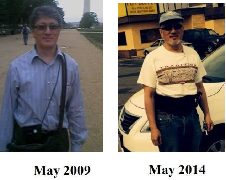Prostate Cancer: What to Know
In Hawaiʿi County, the death rate for prostate cancer is higher than the death rate for breast cancer. Nationally, the death rates for both cancers are nearly identical.
(Source: "How cancer hits Hawaii County", Hawaiʿi Tribune-Herald, 2/08/2016)
Surprised? Prostate cancer is the cancer that no one talks about!
What is a prostate?
The prostate is a walnut-sized gland which sits at the base of men's bladders. It produces the fluid which nourishes and carries sperm, and acts as traffic controller for both urine and semen. Two sphincter muscles adjoin the prostate to control urination: one at the top of the prostate, and the other at the bottom.
Diagnosis: The Beginning
"I am a cancer VICTOR!" At the give year mark after surgery, I celebrated. My cancer journey began seven years earlier...
Screening
Beginning at age 50, men are routinely screened for prostate cancer by (1) a PSA blood test, and (2) a digital (finger) rectal exam. The blood test looks for the presence of a protein associated with the cancer, and the finger test is to find lumps.
[Note: The PSA test is controversial for its high rate of false positives. Today, two new prostate screening tests with improved accuracy are now available: the MiPS blood test and the PCA3 urine test. Your urologist might order these if initial and repeat blood tests reveal a high PSA number, or if biopsy results are inconclusive.]
Monitoring
My doctor referred me to a urologist, who retook the blood test just in case the first result was a “false positive”. The second result was lower BUT still higher than normal for my age. We decided to monitor the situation by retaking the blood test every six months.
Weight Loss
Over the next couple of years, I experienced weight loss of about 20 pounds. I didn’t think about it at the time, but it was likely due to the anxiety of not knowing whether or not I had cancer.
Biopsy
After eighteen months of monitoring, my PSA numbers did not come down. My urologist recommended a prostate biopsy. The test results came back a week later: “You have prostate cancer.”
Treatment Options
Back in 2009, there were basically three options for men less than age 70: (1) “watchful waiting” (continued monitoring, also known as “active surveillance”); (2) radiation therapy, a five week procedure; and (3) surgery. Elderly men are offered (4) hormone therapy, to reduce the hormones which feed the cancer.
Today, newer options are available. Speak with your urologist to learn more.
A Family Decision
During the midst of my many tests and doctor appointments, I received word that my father was gravely ill. I was living in New Jersey at the time. I delayed my return home until after my biopsy and consultation. As soon as I received my diagnosis, I flew back to Hilo.
A day after I arrived, he died. At home that evening, mother pulled me aside. She wanted to talk with me about my cancer: “Back when your father had prostate cancer, he chose radiation treatment. He suffered – I know, I had to take care of him. I don’t want you to suffer like Dad did. Tell the doctor to take it out!”
Before returning to NJ, I got a second opinion from a doctor in our family. I told him that I was leaning toward robotic laparoscopic surgery. After inquiring about my test results, Gleason score, and other information, the doctor concurred: “Da Vinci robotic surgery is the ‘gold standard’. In your case, I’d recommend it.”

Surgery
The Da Vinci robotic prostatectomy is “minimally invasive”, entering through tiny incisions along the waist and belly button. The surgeon controls the robot from a console several few feet away from the patient. One of the advantages of Da Vinci robotic surgery are its stereoscopic cameras and view scope. The surgeon sees a magnified 3D view of the nerves, muscles and blood vessels. The surgeon carefully maneuvers to avoid damaging the nerves which control erections, urination, and bowel movements. My five hour surgery was successful. My cancer was determined to be Type 1 – fully contained within the prostate. It had not spread.
Post-Surgery
The hospital stay is usually one or two days. The hospital nurse warned me about a pain that is “worse than the surgery itself: gas pain." She was right. On the second day following surgery, my internal organs turned back on and generated a lot of gas. It wasn’t relieved until the gas exited over the next couple of days.
Side Effects
The surgery removes more than the cancer. Along with the prostate, the seminal vesicles, and one of two urinary sphincter muscles may be removed. With much of my plumbing gone, there were three frustrating side effects:
Incontinence. You leave the hospital with a catheter tube in your penis and a urine bag strapped to your leg. It is left in place for two or three weeks while your insides heal. After the catheter and urine bag are removed, the one remaining urination sphincter muscle has to learn to do the work of two muscles. The incontinence may be temporary or permanent (if nerves were damaged or cut). Lack of bladder control keeps many men homebound following surgery. To help me return to my normal routines and get out of the house, I used an external catheter kit for several months. It is a condom-like roll-on which connects to the urination hose and bag. With it, you can urinate anytime, anywhere. Just drain it during your next toilet stop. No one knows you’re wearing it under your pants – except for TSA security guards at the airport!
Erectile dysfunction (ED). It may take a while for erections to return to normal. Normal function could return as quickly as two weeks or as long as two years. Your urologist will likely put you on “physical therapy”: daily Kegel exercises, manual stimulation, vibrators and pumps, and pills for ED.
Sterility. Surgery removes most of your reproductive plumbing. Unless the cancer has spread, the testicles remain but the tubes are cut.
Prevention
Prostate cancer is increasingly detected in men in their 30s and 40s. There are no standard protocols yet for screening men under 50, but if you have a family history or are at higher risk, speak with your doctor about earlier screening options.
Studies indicate that only 5% of prostate cancers are hereditary. The rest are considered “environmental”. I asked, “What does the environmental mean?” It’s (mostly) what you eat, what you use, and what’s around you.
Prevention involves getting rid of the cancer-causing chemicals in your foods, bathrooms, kitchens, laundry rooms, garages, and workplaces.
I like the Blue Cure Foundation’s motto: “Cancer prevention begins when men are boys and women are girls.” To prevent prostate cancer in their later years, teens and young men need to change what they eat and live active lifestyles.

